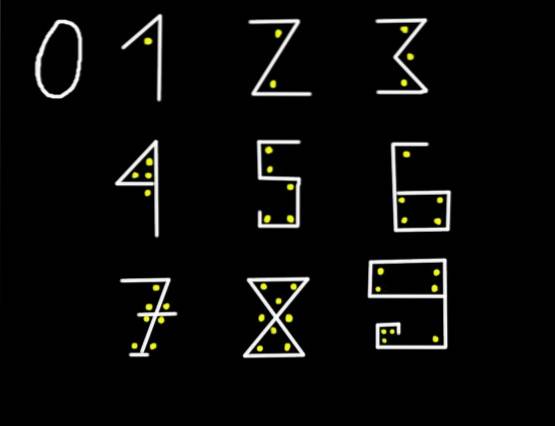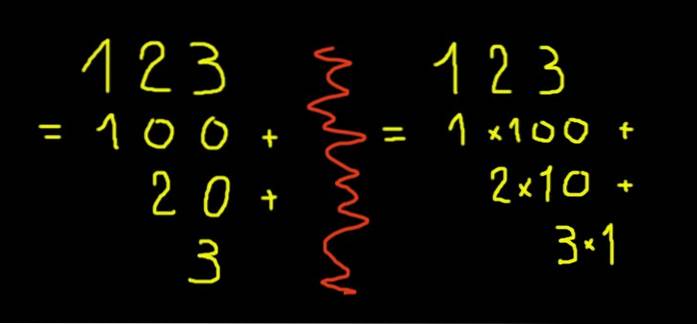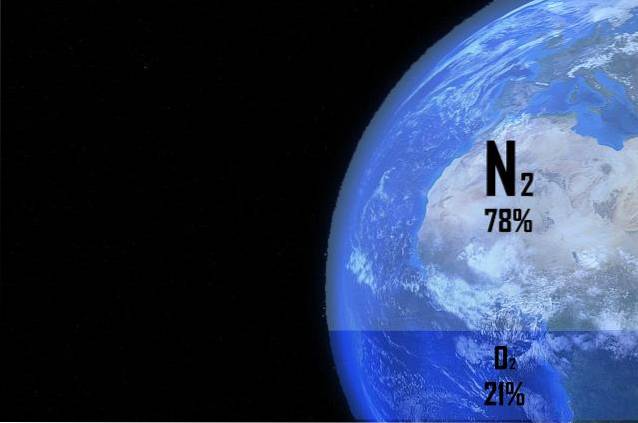
Developed notation what it is, examples and exercises
The expanded notation is one in which a numerical figure is expressed as a sum in which the positional value of each digit that makes up the number is taken into account.
For example, when you write a figure like 2345, each digit in it has a positional hierarchy. Reading from the extreme right digit to the left, the hierarchy or value grows.

In the number 2345, the digit 5 represents five units, the digit 4 represents four tens, the 3 corresponds to the third position from left to right and therefore the 3 represents three hundreds, finally the 2 represents two thousands. In other words, in developed or extended notation, the figure 2345 is written like this:
2345 = 2 thousands + 3 hundreds + 4 tens + 5 ones
But it can also be expressed as follows:
2345 = 2 x 1000 + 3 x 100 + 4 x 10 + 5 x 1.
Also the figure 2345 can be written as the sum of powers of 10:
2345 = 2 x 10 ^ 3 + 3 x 10 ^ 2 + 4 x 10 ^ 1 + 5 x 10 ^ 0
Where the circumflex ^ means raising to the indicated exponent. For example, 10 ^ 3 = 10 x 10 x 10 = 1000. Another way to write the exponents is by using a superscript:
2345 = 2 x 103 + 3 x 10two + 4 x 101 + 5 x 100
Article index
- 1 Positional numbering system
- 1.1 Fractional or decimal numbers
- 2 Examples of expanded notation
- 2.1 Example 1
- 2.2 Example 2
- 3 Exercises of expanded notation
- 3.1 Exercise 1
- 3.2 Exercise 2
- 3.3 Exercise 3
- 3.4 Exercise 6
- 4 References
Positional numbering system
The Arabic numeral system are the numbers that are used daily in the vast majority of continents and countries of the world. Arabic numerals are a base 10 system because ten symbols or graphemes are used to write any number. These ten symbols are:
0 1 2 3 4 5 6 7 8 9
With just one of these symbols, figures from zero to nine can be expressed. To express figures greater than nine, the positional system in base ten is used. The number 10 is a ten and zero units. The number 11 is a ten and a unit. The number 123 (one hundred and twenty-three) is one hundred, two tens, and three ones. Written in the form of powers of ten the number 123 will be:
1 × 10 ^ 2 + 2 × 10 ^ 1 + 3 × 10 ^ 0
Where:
10 ^ 2 = 10 x 10 = 100
10 ^ 1 = 10
10 ^ 0 = 1.
With this example it is clear that the position of the digit at the extreme right is position 0 and represents the number of units, that of the second digit from right to left is position 1 and represents the number of tens, the third digit (from right left) has position 2 and represents the hundreds.

Fractional or decimal numbers
With the decimal positional system it is also possible to represent numbers or figures that are less than the unit or that are greater than the unit but not integers, that is, they have fractions of the unit.
To represent in the Arabic decimal system the fraction ½, that is, half of the unit, is written:
½ = 0.5
To arrive at this expression in our base 10 system, the following operations have been implicitly carried out:
1- The numerator and denominator are multiplied by 5 to have the equivalent fraction 5/10 = 1/2.
2- Dividing by 10 is equivalent to multiplying by the power in base ten with exponent minus one (10 ^ -1), that is, 5/10 = 5 × 10 ^ -1.
3- The negative exponent indicates how many times the indicated digit is moved or positioned to the right from the unit position, in our case it would be 0.5.
4- ½ = 0.5 in extended notation is written like this:
0.5 = 0x10 ^ 0 + 5 × 10 ^ -1
Where 10 ^ -1 = 0.1 is one tenth (the fraction corresponding to the unit divided into 10 equal parts).
In this way, the number 0.5 corresponds to five tenths, but the number 0.05 corresponds to 5 hundredths and 0.005 to 5 thousandths.
Examples of expanded notation
Example 1
Given the figure 40201 in standard notation, convert it to expanded notation.
Solution:
4 × 10000 + 0x1000 + 2 × 100 + 0x10 + 1 × 1 = 40201
Example 2
Write the fraction ¾ in extended notation.
Solution:
In this case you have three-quarters of the unit.
3/4 = 15/20 = 75/100 = 0.75 = 7/10 + 5/100 =
7 × 10 ^ -1 + 5 × 10 ^ -2.
Said in words it would look like this:
The fraction ¾ corresponds to seven tenths plus five hundredths.
Developed notation exercises
Exercise 1
Say in words the expanded expression of the figure 40201 from example 1.
Solution:
The developed notation looks like this:
40201 = 4 × 10000 + 0x1000 + 2 × 100 + 0x10 + 1 × 1
That in word language it is said:
Four tens of thousands, plus zero thousands, plus two hundred, plus zero tens, plus one unit.
Exercise 2
Express the previous figure in words and break down the corresponding phrase in expanded form.
Solution:
The figure 40201 in words is expressed like this:
Forty thousand two hundred one
The previous sentence can be developed as:
40 × 1000 + 2 × 100 + 1
It can be said that the way of pronouncing the figures is a semi-developed way of expressing them.
Exercise 3
Write in expanded form the number 7/3.
Solution:
It is a figure expressed as an improper fraction, since as the numerator is greater than the denominator, the figure is greater than the unit.
This improper fraction can be decomposed as the sum of the fractions 6/3 + 1/3. The first of the fractions results in an integer 2, while 1/3 = 0.333333, where the digit 3 is repeated indefinitely. So the expanded decimal expression of the figure 7/3 will always be an approximate expression:
7/3 = 2 + 1/3 ≃ 2 + 0.333 = 2 + 3 × 10 ^ -1 + 3 × 10 ^ -2 + 3 × 10 ^ -3.
Exercise 6
Write in standard notation and then in expanded form the number: Twenty-three billion two hundred fifty million five hundred twenty-six thousand three hundred twenty-five and three twenty-three thousandths.
Solution:
It should be remembered that a billion is the equivalent of one billion. The word billion it was accepted by the Royal Spanish Academy in 1995 at the request of the late Venezuelan President Rafael Caldera, a member of the Venezuelan Academy of the Language. In that case, the figure for the exercise in standard notation is written like this:
23,2501526,325,023
23 billion + 250 million + 526 thousand + 325 units + 23 thousandths.
23 × 10 ^ 9 + 250 × 10 ^ 6 + 526 × 10 ^ 3 + 325 × 10 ^ 0 + 23 × 10 ^ -3
Finally the figure is written in expanded notation:
2 × 10 ^ 10 + 3 × 10 ^ 9 + 2 × 10 ^ 8 + 5 × 10 ^ 7 + 0x10 ^ 6 + 5 × 10 ^ 5 + 2 × 10 ^ 4 + 6 × 10 ^ 3 + 3 × 10 ^ 2 + 2 × 10 ^ 1 + 5 × 10 ^ 0 + 0x10 ^ -1 + 2 × 10 ^ -2 + 3 × 10 ^ -3.
References
- Khan Academy. Place value charts. Recovered from: es.khanacademy.org
- Khan Academy. Write a number in expanded form (video). Recovered from: es.khanacademy.org
- Ifrah, Geoges (1998): Universal history of figures. Espasa Calpe S.A.
- Wikipedia. Positional notation. Recovered from: es.wikipedia.com
- Wikipedia. Billion. Recovered from: es.wikipedia.com



Yet No Comments